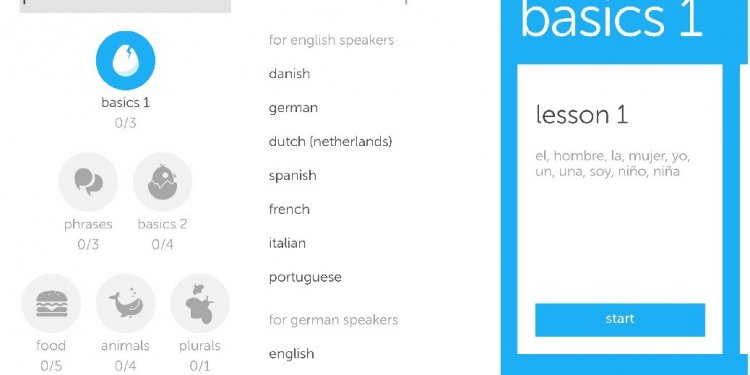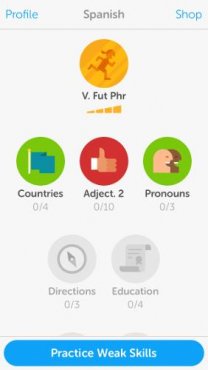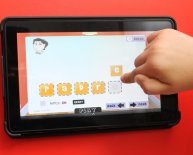
Duolingo app
If you're studying a language, no doubt you've heard of Duolingo, by far the best free program you'll find. The fantastic program comes with equally free mobile apps that let you practice your language on the go, and the iPhone app is, like its website brethren, the best free language-learning app you can find. And with Duolingo, "free" means free—no upsells or locked content whatsoever, and that's largely what makes it so compelling. In addition, top-notch content and a wonderful mobile interface make the Duolingo iPhone app our Editors' Choice for language-learning. The list of languages offered for English-speaking students isn't huge, but it continues to grow, with Polish and Russian being the latest additions.
Although the Duolingo website was significantly updated in 2014, the iPhone app is still a little behind. Gone from the website, for example, are hearts that act like video game lives, in a "three strikes, you're out" kind of way, but they're still present in the Duolingo iPhone app. But that's no big deal seeing as the app is well adapted in so many other ways. You can disable the speaking exercises, for example, in case you want to practice your Italian in a doctor's waiting room, without embarrassing yourself publicly. Considering all the limitations of mobile apps, Duolingo on iPhone is truly impressive. It balances simplicity with great content for reading, writing, hearing, and speaking a language that you're learning.
Supported Languages
If you speak English, Duolingo has language-learning programs for you to learn Danish, Dutch, Esperanto, French, German, Irish, Italian, Norwegian, Polish, Portuguese, Russian, Spanish, Swedish, Turkish, and Ukrainian. Additional language-learning programs are available for speakers of other languages. That's not an exhaustive list, but it does comprise a few of the most popular languages that English speakers want to learn. Plus, Duolingo has a language incubator project, where you can see new languages on the roadmap for rollout. (Previously, a few of the languages in the incubator were readily available, including Mandarin Chinese, but they weren't ready for prime time and thus left to incubate.)
If you're looking to learn a language now that isn't on Duolingo's short list, I would recommend paying for a different program. I've tried many other free mobile language-learning apps, but none are as good as Duolingo. (That said, there are some apps that are specific to one language that are good, but they can be tough to find.) If you're dedicated to learning on the iPhone and your budget is tight, try Pimsleur Comprehensive, which offers dozens of languages, including less in-demand ones. Pimsleur is very audio-focused and not as interactive in the technological sense, but doesn't cost a lot, and the content is solid. You can install Pimsleur's MP3 files on your iPhone in the same way that you'd upload other kinds of music.

If you really want interactive language-learning software and don't mind paying more, I'd encourage you to move to a full-sized computer or laptop and try Rosetta Stone Totale 4, an Editors' Choice, or Fluenz, another very good program. Both Rosetta Stone and Fluenz have Mandarin programs, which is probably the most popular language not included in Duolingo.
How Duolingo Works
From a user's perspective, Duolingo works like most other language-learning programs. You work through exercises or activities in order to complete lessons which are part of larger units. The structure is clear, shown on a dashboard. Icons and short descriptions of the lessons, like "Obj. Pron." (for object pronouns) guide you along your language-learning journey. Fully completed sections turn gold. Sections that you have passed, but have not necessarily completed all of, appear in color with a progress bar beneath them. Sections that are currently locked to you because you don't have the skills yet to do them are gray.
Additionally, the app keeps track of your progress synchronously across both the iPhone app and the Web version. So you can practice conjugating verbs in German at home and pick up where you left off in the iPhone app during your commute.
A placement test that wasn't a part of Duolingo when it first launched now lets new users who are familiar with a language jump ahead to a point in the program that's right for them. Equally helpful is an option to test out of a section, so if you know adverbs really well, you can skip them, so long as you pass the test.
The core learning is extremely clear to see and work through. The language-learning parts are solid and replicate some of the typical drills you'll find in more well-known language software, like Rosetta Stone.
Exercises build on one another so that you're introduced to words and concepts at the right point in the learning schedule. Typical lessons have multiple choice questions, listen-and-write exercises, translation exercises, and spoken exercises, too. In some exercises, you listen to a sentence and write it in the new language. In others, you translate a written sentence from English to the new language, or vice versa. There are multiple choice questions, too, and I love that sometimes there can be more than one right answer—you tap checkmark boxes next to whichever correct answers you see.
Duolingo is forgiving of minor typos, which is excellent, but it's not too lenient either. If your answer is wrong, it marks you wrong and takes away one of your hearts. For each set of exercises, you get three hearts, and when you run out, you have to start that exercise over again.
The service does rely on crowd-sourced information to power its language learning, and occasionally, especially at the higher levels, you might find incorrect information. Fewer people have been at the higher levels, and the content is harder, so it's more likely you'll find an error there. However, they are few and far between, and much less than any other crowd-sourced language learning program I've seen.
Thoughtful Mobile Design
No matter how you start learning and practicing with Duolingo, you can do so with multiple languages. In other words, for the low, low price of nothing, you can start programs in Dutch, Swedish, and Portuguese if you like, whereas many language-learning programs lock you down to just one language. That's pretty incredible.
The exercises in the Duolingo mobile app are very similar to those on the website, but with a few adaptations that make them easier to complete on a tiny mobile phone. In one exercise, for example, the app shows you a sentence, and you have translate it and type it in the language you're learning. On the iPhone, instead of typing each word verbatim, sometimes you'll see a bank of words from which you choose the correct ones and put them into the correct order.
In the Duolingo iPhone app settings, you can disable sound effects, speaking exercises, and listening exercises, which again is extremely helpful for a mobile app. You can also dismiss speaking exercises as they come up without visiting the settings. These kinds of design choices are what make Duolingo exceptional.

















